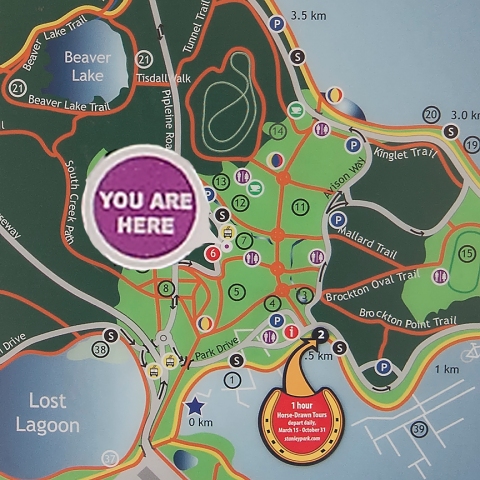Buddhist Cartography: You Are Here.
April 14, 2014 § 5 Comments
I was in Stanley Park looking at the park map when my friend asked, “If we are here, then who are these people by the restrooms?”
Site maps often show two figures to indicate restroom facilities while using a marker of some sort to tell us where we are. As these maps emulate the workings of the human brain it should come as no surprise to learn that the brain also has an inner marker that says, “You are here.” What might come as a surprise is that, as with the site map, there isn’t actually any “you” there at the tip of the marker.
Just as the brain creates inner maps of the outer world, so does it create a map of a self that relates to the world. And just as the maps of the outer world are not the actual world, nor is the map of self your actual Self.
Identifying with the map of self has us believing we are such traits as “unreliable,” “worthless” or “bad” when, in fact, our true nature is clear; just as the water of a lake is clear and only reflects the blue of the sky or the green of the forest.
Most of us have been reading our inner maps for so long that we have forgotten our true nature. Mindfulness and meditation are two practices that train us to turn our attention away from these maps so we may focus, first, on the outer world and, then, our true nature.
In mindfulness we focus our attention on whatever task we are doing at the moment. This turns our attention outward and away from our inner maps. As we progress in this outer focus we become more aware of the inner maps that our brains have superimposed on the world. We begin to see the difference between what “is” going on in the world as opposed to what we “think” is going on.
As part of my practice, I see my inner maps as constructs of the brain that exist only in the brain. I find this a great help in seeing the unreality of thought, as whatever exists in the brain alone can have no real existence in the outer world. This has helped dispel many fears, false beliefs and delusions; and is quite consistent with Tibetan Buddhism where the essential point is to see the world is an illusion.
In meditation the awareness is once again focused away from the inner maps, but this time it is turned back upon itself, i.e., one’s clear, true nature.
Here words become misleading. There is no actual “back” or “upon” in any sense that implies an objective self looking outward at the world. To think there is some person, mind or soul being aware of itself merely replaces one map of self with another, subtler one.
The ultimate form of meditation is Dogen’s shikantaza where one just sits as awareness itself. However, before most of us can “just sit” we need to disengage from our inner maps. We need to put our maps of self and the world aside.
As I mentioned above, I have found it helpful to see my inner maps as fabrications of the brain. This applies not only to the maps I superimposed over the physical world but to my map of self, as well.
The inner map I have of myself is purely a construct of this brain and body. I did not have this map before incarnating into this body and, upon taking a new form, any new map of self will be just as illusory and impermanent as the one I use now.
Ultimately, self is nothing more than a marker on a map that says, “You are here.” The only truth of that marker is that it points to emptiness, which is your true nature and your real Self.

“The only truth of that marker is that it points to emptiness, which is your true nature and your real Self.” If only we were more aware of this…
LikeLike
It would certainly give us greater peace of mind if we let go of false notions of who we are. But many fear letting go, thinking it leads to nothingness. In fact, realizing Self as Emptiness is just another way of saying transcendence. We transcend form and realize Self as formlessness. Then we truly interact with the world without fear or clinging. This is freedom.
LikeLike
Exactly… 🙂
LikeLike
I needed this reminder this morning, thank you. I like that idea of the inner map we creat, so true.
LikeLike
The idea of inner maps helps me see the difference between what’s in my head and what’s out in the world. This has lead to greater peace of mind, a better understanding of Buddhism and what it’s practices are all about. Take care!
LikeLike